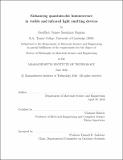| dc.contributor.advisor | Vladimir Bulović. | en_US |
| dc.contributor.author | Supran, Geoffrey James Sasajima | en_US |
| dc.contributor.other | Massachusetts Institute of Technology. Department of Materials Science and Engineering. | en_US |
| dc.date.accessioned | 2016-09-13T18:06:11Z | |
| dc.date.available | 2016-09-13T18:06:11Z | |
| dc.date.copyright | 2016 | en_US |
| dc.date.issued | 2016 | en_US |
| dc.identifier.uri | http://hdl.handle.net/1721.1/104112 | |
| dc.description | Thesis: Ph. D., Massachusetts Institute of Technology, Department of Materials Science and Engineering, 2016. | en_US |
| dc.description | This electronic version was submitted by the student author. The certified thesis is available in the Institute Archives and Special Collections. | en_US |
| dc.description | Cataloged from student-submitted PDF version of thesis. | en_US |
| dc.description | Includes bibliographical references (pages 137-160). | en_US |
| dc.description.abstract | We investigate how the external quantum efficiency (EQE) of colloidal quantum-dot light emitting devices (QD-LEDs) can be enhanced by addressing in situ QD photoluminescence (PL) quenching mechanisms occurring with and without applied bias. QD-LEDs promise efficient, high colour-quality solid-state lighting and displays, and our cost analysis of industrial-scale QD synthesis suggests they can be cost competitive. Efficiency 'roll-off' at high biases is among the most enduring challenges facing all LED technologies today. It stands in the way of high efficiencies at high brightness, yet it has not previously been studied in QD-LEDs. Simultaneous measurements of QD electroluminescence (EL) and PL in an operating device allow us to show for the first time that EQE roll-off in QD-LEDs derives from the QD layer itself, and that it is entirely due to a bias-driven reduction in QD PL quantum yield. Using the quantum confined Stark Effect as a signature of local electric fields in our devices, the bias-dependence of EQE is predicted and found to be in excellent agreement with the roll-off observed. We therefore conclude that electric field-induced QD PL quenching fully accounts for roll-off in our QD-LEDs. To investigate zero-bias PL quenching, we fabricate a novel near-infrared (NIR)-emitting device based on core-shell PbS-CdS QDs synthesised via cation exchange. QDs boast high PL quantum yield at wavelengths beyond 1 [mu]m, making them uniquely suited to NIR applications such as optical telecommunications and computing, bio-medical imaging, and on-chip bio(sensing) and spectroscopy. Core-shell PbS-CdS QDs enhance the peak EQE of core-only PbS control devices by 50- to 100-fold, up to 4.3 %. This is more than double the efficiency of previous NIR QD-LEDs, making it the most efficient thin-film NIR light source reported. PL measurements reveal that the efficiency enhancement is due to passivation of the PbS core by the CdS shell against a non-radiative recombination pathway caused by a neighboring conductive layer within the device architecture. | en_US |
| dc.description.statementofresponsibility | by Geoffrey James Sasajima Supran. | en_US |
| dc.format.extent | 160 pages | en_US |
| dc.language.iso | eng | en_US |
| dc.publisher | Massachusetts Institute of Technology | en_US |
| dc.rights | M.I.T. theses are protected by copyright. They may be viewed from this source for any purpose, but reproduction or distribution in any format is prohibited without written permission. See provided URL for inquiries about permission. | en_US |
| dc.rights.uri | http://dspace.mit.edu/handle/1721.1/7582 | en_US |
| dc.subject | Materials Science and Engineering. | en_US |
| dc.title | Enhancing quantum-dot luminescence in visible and infrared light emitting devices | en_US |
| dc.type | Thesis | en_US |
| dc.description.degree | Ph. D. | en_US |
| dc.contributor.department | Massachusetts Institute of Technology. Department of Materials Science and Engineering | |
| dc.identifier.oclc | 958136143 | en_US |
